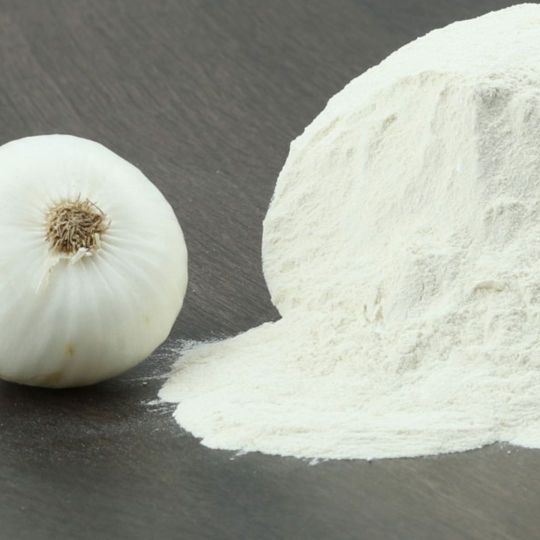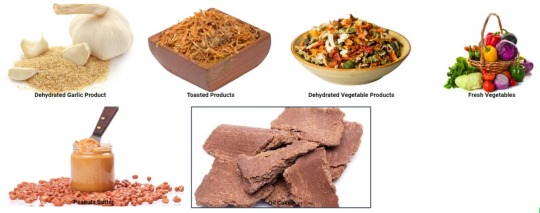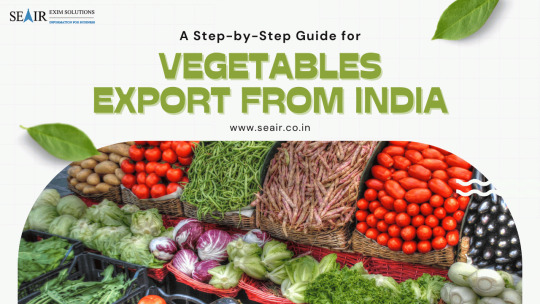#vegetables exporters in india
Explore tagged Tumblr posts
Text
India's Flourishing Vegetables Export Industry: A Detailed Insight

India, with its vast agricultural resources and diverse climate, has established itself as a significant player in the global vegetables market. The country's vegetables export from India has seen remarkable growth, contributing to the economy and meeting international demand for fresh and dehydrated vegetables. This article delves into the nuances of vegetables export from India, examining key data, leading exporters, and major importing countries.
The Significance of Vegetables Export from India
India's agriculture sector plays a crucial role in the economy, with vegetables forming a substantial part of the export portfolio. The country's rich soil and varied climatic conditions allow for the cultivation of a wide range of vegetables, which are exported to numerous countries worldwide.
Overview of Vegetables Export Data
Vegetables export data indicates a robust and growing industry. In recent years, India has exported millions of tonnes of vegetables, generating substantial revenue. The vegetables hs code, which is the harmonized system code used to classify goods in international trade, for fresh and dehydrated vegetables falls under chapters 07 and 20 respectively, helping streamline and categorize the export process.
List of Vegetables Exported from India
India exports a diverse range of vegetables, both fresh and dehydrated. The list of vegetables exported from India includes:
Onions
Potatoes
Tomatoes
Green chilies
Okra
Eggplants
Carrots
Spinach
Cabbages
Cauliflowers
Most Exported Vegetables from India
Among these, the most exported vegetables from India are onions, potatoes, and tomatoes. These vegetables are in high demand due to their versatility, nutritional value, and extensive use in various cuisines around the world.
Export of Dehydrated Vegetables from India
In addition to fresh vegetables, the export of dehydrated vegetables from India has also gained momentum. Dehydrated vegetables, such as dried onions, garlic, and green beans, offer longer shelf life and ease of transport, making them a preferred choice for many international markets. Dehydrated vegetables exporters in India have capitalized on this demand, ensuring high-quality products through advanced processing techniques.
Vegetables Exporters in India
India boasts numerous reputable vegetables exporters who have established a strong presence in the global market. These exporters ensure that Indian vegetables meet international quality standards and are delivered fresh. Some of the leading names include:
Allanasons Pvt Ltd
Tirupati Balaji Agro Products Pvt Ltd
Atmiya International
S K Fresh Produce
K M Exports
Major Vegetable Importing Countries
The list of vegetable importing countries from India includes several major economies and emerging markets. The primary vegetable importing countries from India are:
United Arab Emirates
Saudi Arabia
Bangladesh
Malaysia
Sri Lanka
United Kingdom
Netherlands
Nepal
Qatar
Germany
These countries import significant quantities of Indian vegetables due to their high quality, competitive pricing, and the reliability of Indian exporters.
India's Position Among Top Vegetable Exporting Countries
India is consistently ranked among the top 10 vegetable exporting countries in the world. The country's strategic advantage lies in its ability to produce a wide variety of vegetables throughout the year, ensuring a steady supply to international markets.
Challenges Faced by Vegetable Exporters in India
Despite the success, vegetables exporters in India face several challenges, including:
Quality Control: Maintaining consistent quality to meet international standards.
Logistics: Ensuring efficient cold chain logistics to preserve the freshness of vegetables.
Regulatory Compliance: Navigating various international trade regulations and phytosanitary standards.
Climate Variability: Dealing with the impact of climate change on crop yields.
Government Support and Initiatives
The Indian government has implemented several initiatives to support vegetables export from India. Schemes such as the Agricultural and Processed Food Products Export Development Authority (APEDA) provide financial assistance, quality control support, and market access initiatives to boost exports.
Sustainability and Organic Farming
Sustainability is becoming a focal point in the agriculture sector. Many Indian farmers and exporters are adopting organic farming practices to meet the growing global demand for organic produce. This shift not only enhances the marketability of Indian vegetables but also promotes environmental conservation and soil health.
Technological Advancements in Vegetable Farming
Technological advancements are playing a pivotal role in enhancing the efficiency and productivity of vegetable farming in India. Innovations such as precision farming, drip irrigation, and controlled environment agriculture are helping farmers increase yields and improve quality.
Future Prospects of Vegetables Export from India
The future of vegetables export from India looks promising, with increasing global demand for fresh and high-quality produce. Expanding market access, improving logistics infrastructure, and adopting sustainable farming practices are expected to drive growth in this sector. Additionally, the rise of e-commerce platforms is opening new avenues for direct-to-consumer sales, further boosting exports.
Conclusion
The vegetables export industry in India is a dynamic and vital component of the agricultural sector. With a diverse range of high-quality vegetables, reliable exporters, and strong government support, India continues to strengthen its position in the global market. As the industry navigates challenges and embraces innovation, the future of vegetables export from India looks bright and full of potential.
#vegetables export from india#vegetables export data#vegetables hs code#india vegetable export#vegetables exporters in india#vegetables importers#vegetable importing countries#top 10 vegetable exporting countries#list of vegetables exported from india#export of dehydrated vegetables from india#vegetable importing countries from india#dehydrated vegetables exporters india#most exported vegetables from india
0 notes
Text

Discover India's flourishing vegetable export market. Learn about production statistics, top exporters, HS codes, and how to start exporting vegetables from India. Explore key markets and trends driving India's green gold industry.
#vegetables export from india#vegetables export data#vegetables hs code#india vegetable export#vegetables exporters in india#vegetables importers#vegetable buyers#vegetable importing countries#top 10 vegetable exporting countries
0 notes
Text
Discover the flourishing vegetable export market in India with our comprehensive guide. Learn about production statistics, key exporters, HS codes, top export destinations, and how to get started in the lucrative vegetable export market. Unlock the potential of India's green gold today!
#vegetables export from india#vegetables export data#vegetables hs code#india vegetable export#vegetables exporters in india#vegetables importers#vegetable buyers#vegetable importing countries#top 10 vegetable exporting countries
0 notes
Text

#Fresh Vegetables#Organic Vegetables#Vegetables#natural vegetables#supplier#Exporter#Maharashtra#Mumbai#India#Tomatoes#Potatoes#Carrots#Bell Peppers#India export data of Vegetables
2 notes
·
View notes
Text

Read the full article here
#vegetable business#vegetables#vegetable slicer and chopper#vegetable chopper#vegetable seeds online india#vegetables export from india#frozen vegetables business in india#india vegetable market#vegetable selling#indian vegetable seeds online#vegetable business plan#vegetable cutter#vegetable export from india#how to start vegetable business in india#vegetable business ideas#vegetables cheap rates available in india
2 notes
·
View notes
Text
Dehydrated Onion Exporter: A Gateway to Global Markets
India, renowned for its rich agricultural heritage, is a leading producer and exporter of a diverse range of agricultural commodities. Among these, Dehydrated Onion occupies a significant position in the global market. This article delves into the Indian dehydrated onion export landscape, highlighting key aspects, challenges, and opportunities.
The Indian Advantage
India boasts a favorable climate and fertile land, ideal for cultivating a wide array of crops, including Fresh Onion. The country's abundant onion production provides a robust foundation for the thriving dehydrated onion industry.

Quality and Variety: Indian onions are known for their high quality, distinct flavor, and nutritional value. This, coupled with advanced dehydration technologies, ensures the production of premium Dehydrated Onion products that cater to diverse global demands.
Competitive Pricing: India's competitive labor costs and efficient production processes contribute to making Dehydrated Onion exports highly cost-effective.
Abundant Raw Material: The consistent availability of high-quality Fresh Onion within the country ensures uninterrupted supply for the dehydration industry.
Dehydrated Onion: A Versatile Ingredient
Dehydrated Onion is a versatile ingredient widely used in various food and culinary applications across the globe.
Convenience Food: It is a key component in instant noodles, soups, sauces, and other convenience foods, offering a convenient and flavor-enhancing solution.
Processed Foods: Dehydrated Onion finds extensive use in processed foods such as frozen meals, snacks, and bakery products.
Industrial Applications: It is used in various industrial applications, including flavoring agents, seasonings, and animal feed.
Export Markets and Trends
Dehydrated Onion from India is exported to numerous countries worldwide, with key markets including Southeast Asia, the Middle East, Europe, and the United States.

Growing Demand: The global demand for Dehydrated Onion is steadily increasing, driven by factors such as urbanization, changing consumer preferences, and the growth of the food processing industry.
Value-Added Products: There is a growing focus on exporting value-added products such as Fried Onion, Dehydrated Garlic, and other Dehydrated Vegetable Product And Spices.
Organic Production: The demand for organic Dehydrated Onion is on the rise, presenting significant opportunities for Indian exporters.
Challenges and Opportunities
While the Indian dehydrated onion export industry presents immense potential, it also faces several challenges:
Quality Control: Maintaining consistent quality and adhering to stringent international food safety standards is crucial for sustained success in the global market.
Competition: Intense competition from other onion-producing countries necessitates continuous innovation and value addition.
Infrastructure: Enhancing logistics infrastructure, including cold storage and transportation facilities, is essential for efficient and timely delivery of products to international markets.
Opportunities for Growth
Technological Upgradation: Adopting advanced dehydration technologies can improve product quality, enhance efficiency, and reduce production costs.
Brand Building: Building strong brand equity for Indian Dehydrated Onion in international markets is crucial to gain a competitive edge.
Diversification: Exploring new markets and diversifying product offerings, including Groundnut, Maize, Groundnut oil cake, Raw Peanut, Roasted Peanut, and other Dehydrated Vegetable Product And Spices, can enhance export revenue.
Government Support: Government initiatives such as trade facilitation measures, market intelligence, and financial assistance can significantly boost exports.

Conclusion
The Indian dehydrated onion export industry holds immense potential for growth and development. By addressing the challenges and capitalizing on the opportunities, India can further strengthen its position as a leading exporter of high-quality Dehydrated Onion and other agricultural commodities in the global market.
#Ays#onion supplier#dehydrated onion supplier in india#dehydrated onion exporter#dehydrated vegetables#dehydrated product#dry vegetables
0 notes
Text

#Dehydrated Vegetables Exporter#Dehydrated Vegetables Supplier#Dehydrated Vegetables#Manufacturers#Suppliers#Exporters#Producers#India#Punjab#Dehydrated Vegetables Price#Fresh Dehydrated Vegetables#Export Dehydrated Vegetables
0 notes
Text

#Fresh Garlic#Organic Garlic#Garlic#premier Garlic#top Garlic#Vegetables#India export data of Garlic#natural Garlic#Garlic Exporter#Garlic in India#Spices#Indian Masala#Exporter#Supplier#Uttar Pradesh#India
0 notes
Text

#Fresh Green Chilli#Natural Green Chilli#Green Chilli Exporter#Green Chilli#Green Chilli Supplier#Fresh Green Chilli India#vegetables#Export Green Chilli#Green Chilli Tamil Nadu#Exporter#Supplier#India#Tamil Nadu
0 notes
Text
Tips to effectively transport fruits for export purposes
Visit our website https://www.impexbee.com/ or contact us at: +91 8983374363 for more information.
#Export Spices from India#Fruit Export Companies in India#Top Fruit Export Companies in India#Online Fruits and Vegetables#Vegetable Export from India
0 notes
Text
#Fresh Bell Pepper#Organic Bell Pepper#Bell Pepper#premier Bell Pepper#top Bell Pepper#Vegetables#supplier#Exporter#Gujarat#India#India export data of Bell Pepper#natural Bell Pepper#Bell Pepper export data
0 notes
Text
How Is Frozen Food Export from India Revolutionizing Global Trade?

What Is Frozen Food Export from India?
Frozen food export from India involves the shipment of frozen food products, including vegetables, fruits, ready-to-eat meals, seafood, and poultry, to countries around the world. India’s vast agricultural base and improving cold storage and supply chain infrastructure have positioned it as a significant player in the global frozen food market. Frozen food exports from India are growing rapidly, driven by global demand for convenient, nutritious, and long-lasting food products. This article explores the frozen food market in India, key players, and the challenges and opportunities within the sector.
Why Is Frozen Food Export from India Growing?
The global demand for frozen food has increased significantly due to changes in consumer behavior, rising urbanization, and the need for convenient meal options. Several factors contribute to the growing frozen food exports from India:
Growing Demand for Convenience Foods: With consumers looking for convenient food options that require minimal preparation, frozen food fits the bill perfectly. This has led to a surge in the demand for frozen food products globally.
Technological Advancements in Food Processing: The adoption of modern freezing techniques, such as Individual Quick Freezing (IQF), ensures that frozen food retains its nutrients, taste, and quality, making India’s products competitive in global markets.
India’s Agricultural Abundance: India’s vast and diverse agricultural base provides a continuous supply of raw materials, particularly vegetables and seafood, allowing the country to consistently meet the demand for frozen food exports.
These factors highlight why frozen food export from India is witnessing steady growth and contributing significantly to the country’s economy.
What Are the Major Products in Frozen Food Exports from India?
India exports a wide variety of frozen food products, each playing a key role in its international trade. The major categories that dominate frozen food exports from India include:
Frozen Vegetables: One of the most significant contributors to frozen food export from India is frozen vegetables. Vegetables like peas, spinach, carrots, and mixed vegetables are exported to countries around the world, especially to regions where fresh produce is scarce or expensive.
Frozen Seafood: India is one of the leading exporters of frozen seafood, with shrimp, fish fillets, and prawns among the top products shipped to countries such as the United States, Japan, and Europe.
Ready-to-Eat Frozen Meals: With Indian cuisine gaining global popularity, the export of frozen ready-to-eat meals, such as biryani, curries, and samosas, is increasing. These products are popular in markets where Indian food is sought after, particularly in Europe and North America.
Frozen Fruits: Frozen fruits, especially mangoes, are highly sought after, with exports going to regions such as the Middle East, Europe, and North America.
Frozen vegetables export from India, along with other frozen food products, continues to rise due to their convenience and growing popularity in international markets.
Who Are the Leading Frozen Food Exporters in India?
Several companies in India have emerged as leaders in the frozen food export sector. These frozen food exporters are known for their quality, reliability, and ability to meet global demand. Some of the leading frozen food exporters in India include:
Allanasons Pvt. Ltd.: Specializing in frozen meat, seafood, and vegetables, Allanasons is one of India’s largest frozen food exporters with a vast international reach.
Mother Dairy Fruit & Vegetable Pvt. Ltd.: Known for its Safal brand, Mother Dairy is a significant player in frozen vegetables export from India and supplies to markets across Asia and the Middle East.
Venky’s: A key name in the frozen poultry market, Venky’s exports frozen chicken and meat products to various global destinations, known for its high quality and hygiene standards.
These frozen food exporters in India have established strong connections with international markets, allowing Indian frozen food products to reach supermarkets, hotels, and food chains worldwide.
What Does the Frozen Food Market in India Look Like?
The frozen food market in India is growing rapidly, driven by both exports and increasing domestic consumption. Indian consumers are gradually embracing frozen food due to lifestyle changes, increased awareness of its convenience, and the growth of organized retail. Key trends in the frozen food market in India include:
Rising Demand for Frozen Vegetables and Fruits: Frozen vegetables and fruits are becoming staples in Indian households as they offer convenience, reduce preparation time, and help avoid food wastage.
Growth of Ready-to-Eat Meals: The ready-to-eat frozen food segment is expanding due to the rising number of working professionals and the fast-paced urban lifestyle.
Health Consciousness: As consumers become more health-conscious, there is growing demand for organic and preservative-free frozen food options, pushing Indian producers to focus on high-quality, natural products.
These factors reflect the dynamic frozen food market in India, which has the potential to expand further as both domestic and global demand rises.
What Are the Key Markets for Frozen Food Exports from India?
Frozen food exports from India reach numerous countries across different regions. Some of the key markets for Indian frozen food include:
United States: The U.S. is a major importer of frozen Indian seafood, particularly shrimp, which is a highly popular product in American supermarkets and restaurants.
Europe: Countries like the United Kingdom, Germany, and the Netherlands import significant amounts of frozen vegetables and ready-to-eat meals from India.
Middle East: Indian frozen fruits, particularly mangoes, and vegetables are in high demand in Middle Eastern countries like the UAE, Saudi Arabia, and Qatar.
Japan and Southeast Asia: India also exports frozen seafood and vegetables to Japan and Southeast Asian countries, which value Indian products for their quality and taste.
India’s ability to cater to these diverse markets ensures its continued success in the global frozen food trade.
What Are the Challenges Facing Frozen Food Exporters in India?
While frozen food export from India has seen significant growth, the industry still faces several challenges. These challenges include:
Cold Chain Infrastructure: Although India has made significant advancements in cold chain infrastructure, there are still gaps in rural areas and remote regions, which can affect the quality of frozen food products during transport.
Fluctuating Raw Material Prices: The prices of raw materials, such as vegetables and seafood, can fluctuate due to seasonal factors, impacting the cost of production and export profitability.
Stringent International Standards: Frozen food exporters must adhere to strict quality and safety regulations set by importing countries, such as the U.S. and the European Union, to ensure the food meets international standards.
Overcoming these challenges is essential for frozen food exporters in India to maintain and grow their presence in international markets.
How Can Technology Improve Frozen Food Export from India?
Technology is playing an increasingly important role in the frozen food industry in India. Several advancements have improved the quality, safety, and efficiency of frozen food exports. Key technological improvements include:
Advanced Freezing Techniques: Innovations like Individual Quick Freezing (IQF) have improved the preservation of food products, ensuring they retain their flavor, texture, and nutrients.
Better Cold Chain Management: Investments in temperature-controlled storage facilities, refrigerated trucks, and logistics have enhanced the cold chain, ensuring that frozen food reaches its destination in optimal condition.
E-commerce and Digital Platforms: The rise of digital platforms and e-commerce solutions has allowed frozen food exporters to reach new markets and streamline the export process, providing real-time updates and tracking.
Embracing these technologies allows frozen food exporters in India to meet international demand with high-quality products that remain fresh and nutritious.
What Is the Future of Frozen Food Exports from India?
The future of frozen food export from India looks promising, with several emerging trends indicating continued growth. Opportunities for future expansion include:
Organic and Sustainable Products: With the rise in health-conscious consumers globally, there is growing demand for organic and sustainably sourced frozen food. Indian exporters can tap into this trend by offering certified organic frozen vegetables and fruits.
Exploring New Markets: While the U.S. and Europe are key markets, frozen food exporters from India can explore new and emerging markets in regions like Africa and South America.
Government Support and Incentives: The Indian government has been providing various incentives to boost the agricultural and frozen food sectors, which will likely spur further growth in exports.
By focusing on these trends and opportunities, frozen food exports from India will continue to expand and play a key role in global food supply chains.
Conclusion: How Is Frozen Food Export from India Shaping Global Trade?
Frozen food export from India is making a significant impact on global trade, with the country becoming a major supplier of frozen vegetables, seafood, and ready-to-eat meals. With growing demand in international markets and advancements in technology, frozen food exporters in India are well-positioned to meet the needs of consumers worldwide. As India strengthens its cold chain infrastructure and explores new markets, the future of frozen food exports from India looks brighter than ever, further solidifying the country's role as a global leader in the frozen food industry.
#frozen food export from India#frozen food exports from India#frozen food exporters#frozen food exporters in India#frozen vegetables export from India#frozen food market in India
0 notes
Text
https://www.seair.co.in/blog/vegetables-export-from-india.aspx

India, the land of farmers, has a perfect climate for farming. India's agricultural sector is very vast, which makes India a prime producer and exporter of many agricultural products. One of the main agricultural products, vegetables, is rising as the green gold of India due to its high export value and economic support for the nation in many ways. This blog will teach about vegetable export data, Vegetables export from India, and more.
#vegetables export from india#vegetables export data#vegetables hs code#india vegetable export#vegetables exporters in india#vegetables importers#vegetable buyers#vegetable importing countries#top 10 vegetable exporting countries
0 notes
Text

#Natural Potato#Natural Potato Exporter#Carrot#Fresh Potato Produce#Fresh Potato#Fresh Potato in India#Potato price in India#root vegetables#top Potato#White Potato#yellow Potato#red Potato#Export Potato#Produce Potato#Potato in Tamil Nadu#Exporter#produce#India#Tamil Nadu
0 notes
